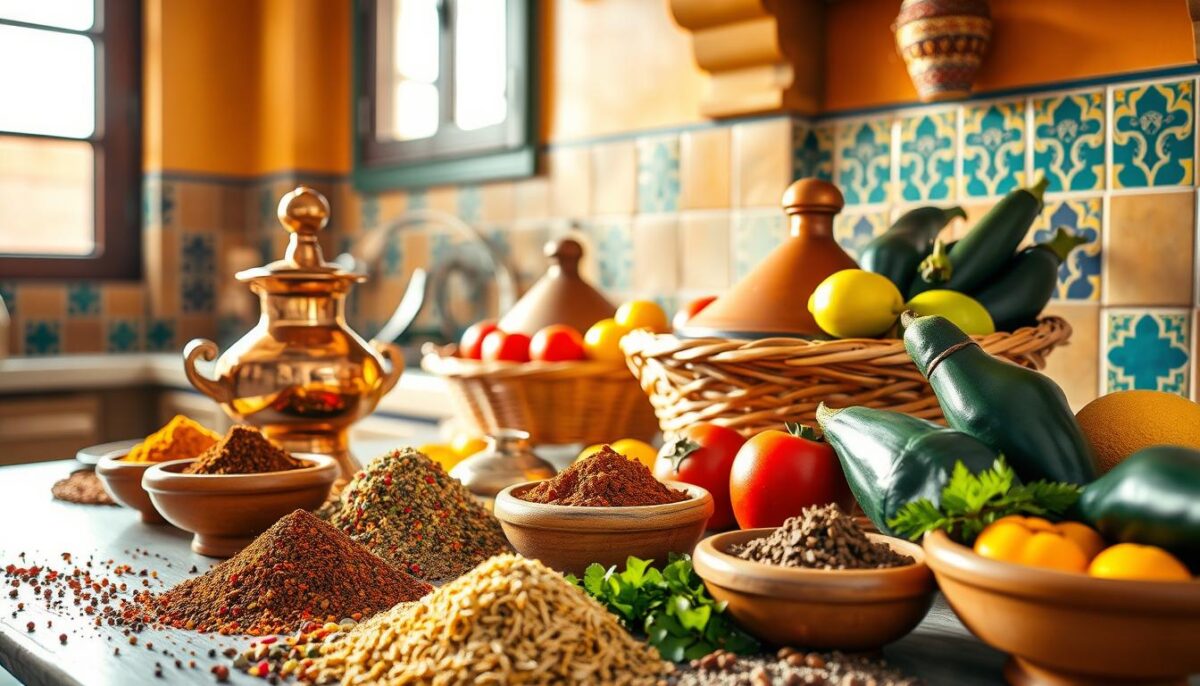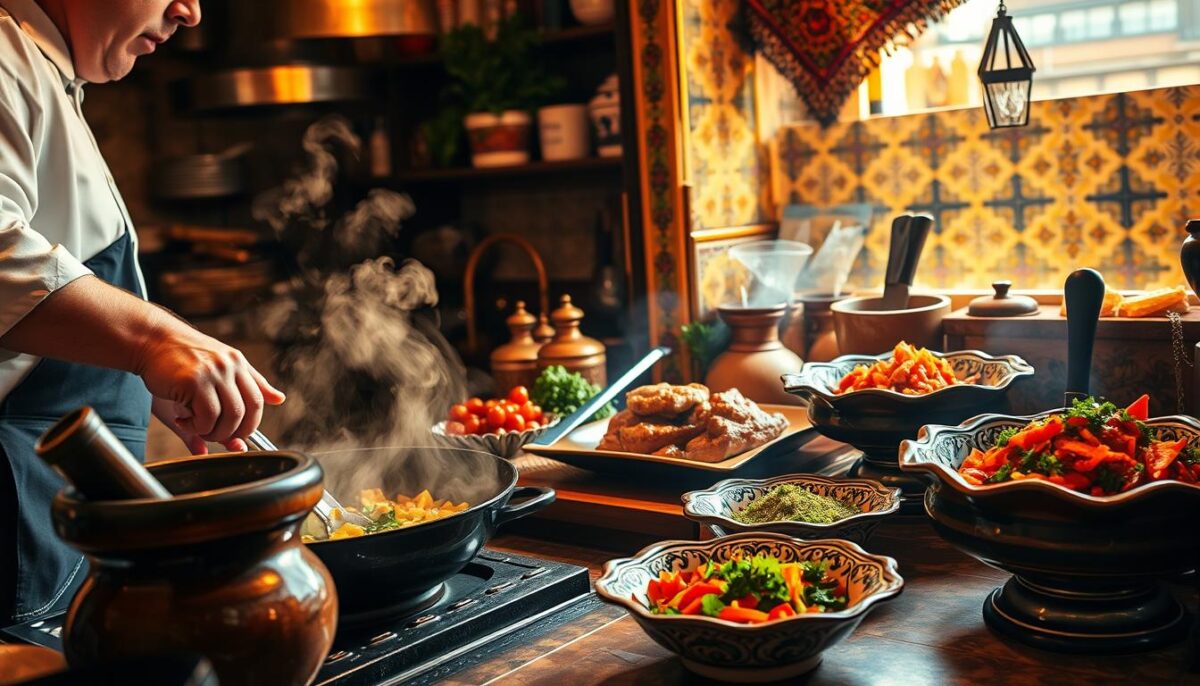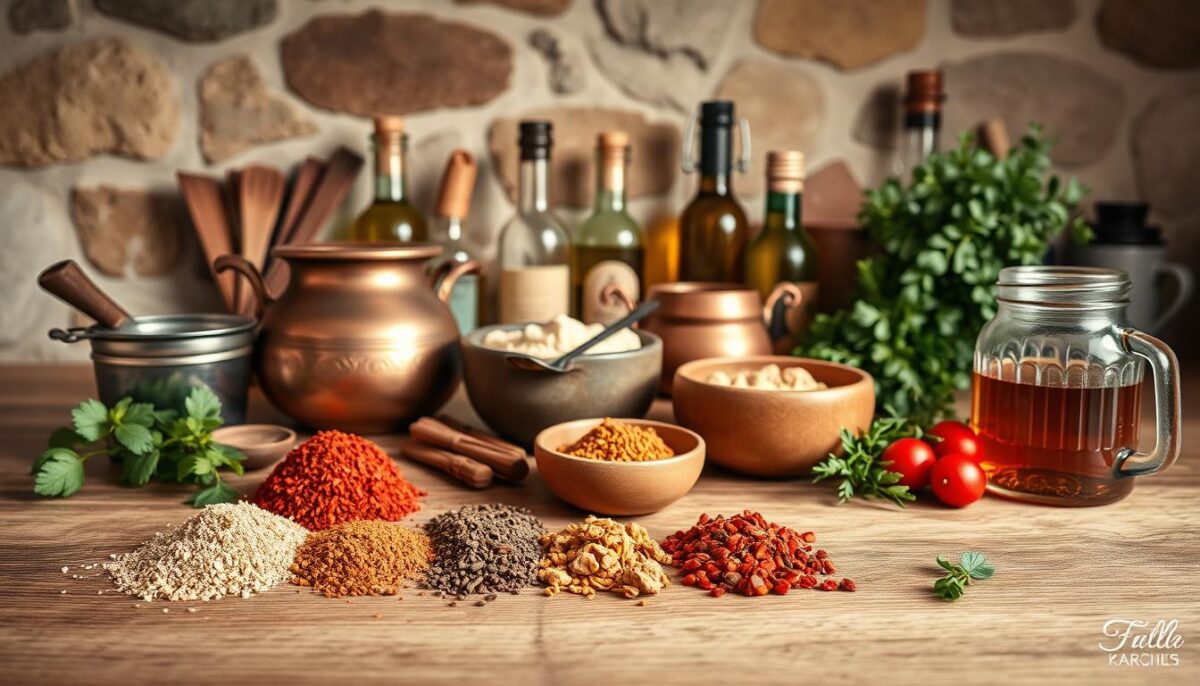
Exploring Moroccan Flavors: Tagines, Spices, and Sweet Treats
April 28, 2025
Argentinian BBQ Secrets: How to Master Asado at Home
April 28, 2025I still remember the first time I tasted a dish that made me pause mid-bite. It wasn’t just the burst of lemon and parsley—it was the way every flavor felt alive, like a story unfolding on my tongue. That moment, years ago at a friend’s dinner table, introduced me to tabbouleh. It wasn’t just a salad; it was an invitation to explore a culture through its plates.
Back then, I never imagined I’d be sharing my own kitchen experiments. But that’s the magic of this cuisine: it turns curiosity into passion. My early attempts were messy—too much bulgur here, not enough mint there—but each imperfect batch taught me something new. I discovered that even simple dishes, like hummus or grilled meats with za’atar, carry generations of tradition.
What keeps me hooked? The balance. Fresh herbs dance with earthy spices, and meals feel nourishing without being heavy. Best of all, you don’t need fancy tools or hours to create something memorable. A sharp knife, a handful of vibrant ingredients, and a willingness to try are enough to begin.
Key Takeaways
- Lebanese dishes celebrate fresh, seasonal ingredients for bright, layered flavors.
- Starting with easy recipes builds confidence and sparks creativity.
- Traditional elements like olive oil and herbs connect meals to cultural roots.
- Mistakes in the kitchen often lead to delicious surprises.
- Sharing these dishes creates meaningful moments with loved ones.
Discovering the Rich Heritage of Lebanese Cuisine
My journey into this culinary tradition began with a simple drizzle of golden oil over warm pita. That first taste revealed more than a condiment—it whispered stories of ancient Phoenician traders and sun-drenched Mediterranean hillsides. Centuries of crossroads culture left their mark here, blending Ottoman spice routes with French refinement.
Where History Meets the Plate
What makes these dishes timeless? Geography. Mountain herbs meet coastal citrus, while garlic and onion form the base of nearly every sauce. I once read a 19th-century traveler’s diary describing Beirut markets: “Olive oil flows like liquid gold, scenting the air with promises of feasts.” That promise still holds today.
The Flavor Foundations
Three elements define authentic recipes:
| Ingredient | Role | Signature Use |
|---|---|---|
| Extra virgin olive oil | Rich base | Drizzling, marinades |
| Fresh lemon juice | Bright acidity | Salads, dips |
| Garlic & herbs | Layered depth | Spice blends, garnishes |
During my first trip to Byblos, a home cook showed me her family’s trick: always crush garlic with salt to unlock its sweetness. This attention to technique transforms basic components into vibrant flavors. Modern chefs now revisit these methods, proving tradition never goes stale.
Essential Tips for Lebanese food cooking start
Five years ago, my countertop looked like a spice bazaar explosion—jars of sumac tumbling over cumin packets while pomegranate molasses dripped onto my cutting board. That chaos taught me an unexpected lesson: great meals begin long before the stove gets hot. Organizing your space and ingredients isn’t just practical—it’s how you honor the rhythm of middle eastern culinary traditions.

Setting Up My Kitchen for Success
I learned the hard way that extra virgin olive oil deserves front-row shelf space. Store spices in labeled jars near your prep area—you’ll use them daily. My go-to tools? A mortar and pestle for crushing garlic into velvety paste and a citrus juicer for fresh lemon. One cookbook tip changed everything: “Treat your olive oil like fine wine—store it dark and cool.”
Simple First Steps to Embrace the Craft
Start with garlic sauce. Mix crushed garlic, lemon, and a pinch of salt into Greek yogurt for a bright dip. It’s an easy make project that teaches flavor balance. When I first nailed this, my neighbor joked, “Tastes like Beirut in a bowl!” That’s the magic of using virgin olive oils and fresh herbs—they turn simple steps into memorable meals.
My biggest surprise? Even best lebanese chefs embrace imperfection. A slightly charred pita or over-chopped parsley still delights. Keep za’atar within reach, and let your kitchen tell its own story—one fragrant, tangy bite at a time.
Mastering Key Lebanese Recipes
I once burned an entire batch of garlic while multitasking between chickpeas and parsley. That smoky disaster taught me more about patience than any cookbook ever could. These iconic dishes demand attention to detail—but reward you with flavors that feel like coming home.
Classic Hummus and Tabbouleh Techniques
Perfecting hummus starts with texture. A chef in Beirut once told me, “Peel your chickpeas like you’re unwrapping gifts.” Combine them with tahini, lemon, and a generous pour of olive oil—the golden thread tying everything together. For tabbouleh, chop herbs until your knife sings. Balance is key: more parsley than bulgur, more lemon than ego.
Delicious Variations of Kibbeh
My first kibbeh resembled a cracked asteroid. But mixing bread crumbs with bulgur and spices became a game-changer. Try stuffing them with date paste and toasted pine nuts for sweetness that surprises. A friend’s grandmother shared her secret: “Shape them with wet hands—like you’re holding moonlight.”
Through burnt garlic and crumbled experiments, I learned these recipes aren’t just meals. They’re edible history. Each creamy dip or spiced croquette whispers centuries of shared tables and perfected techniques.
My Favorite Lebanese Cooking Techniques
I learned early that vibrant dishes begin with crisp ingredients straight from the market. My aunt once handed me a bunch of parsley saying, “Leaves should snap like applause when they’re fresh.” That lesson shaped how I approach every meal.

Flavor Through Freshness
Three rules guide my prep work:
| Ingredient | Selection Tip | Best Use |
|---|---|---|
| Parsley | Choose flat-leaf, no yellow edges | Tabbouleh base |
| Yogurt | Full-fat, room temperature | Garlic dip base |
| Lemons | Heavy = more juice | Dressings & marinades |
For cookies and cake, I use orange blossom water sparingly—too much tastes like perfume. My trick? Add a teaspoon to the flour first for even distribution.
Oil as Your Paintbrush
Extra virgin olive oil transforms dishes when used strategically:
- Drizzle over yogurt with za’atar for breakfast
- Brush on cookies before baking for golden edges
- Whisk with lemon for salads that make ingredients sing
I once ruined a cake by using bitter oil. Now I taste it first—good oil should leave your throat slightly peppery. As my mother says, “Oil is the soul of the plate—choose wisely.”
Bringing Lebanese Flavors Home: Tools & Ingredients
My mom’s spice drawer always smelled like adventure. Cinnamon sticks poked out between jars of allspice and dried mint, each scent hinting at possibilities. Building your own toolkit starts with three essentials: quality olive oil, bright citrus, and spices that tell stories through every sprinkle.

Must-Have Spices and Pantry Staples
These four ingredients form the backbone of countless recipes:
| Spice | Flavor Profile | Mom’s Tip |
|---|---|---|
| Sumac | Tart, fruity | Mix with onions for salads |
| Za’atar | Earthy, herbal | Sprinkle on eggs at breakfast |
| Cardamom | Warm, aromatic | Grind fresh for desserts |
| Mahlab | Nutty, cherry-like | Use in holiday breads |
My first successful baklava happened when I followed mom’s advice: “Let the spices breathe—toast them lightly before grinding.” This unlocks flavors that pre-packaged blends can’t match.
The Role of Extra Virgin Olive Oil in Authentic Recipes
A book by chef Anissa Helou changed how I view olive oil. She writes: “It should taste like the land—grassy, peppery, alive.” Mom keeps hers in a dark glass bottle, reserved for finishing dishes. Drizzle it over hummus or lemon-dressed greens to elevate simple meals.
For desserts like ma’amoul cookies, we use oil instead of butter. It creates melt-in-your-mouth texture while letting rose water and pistachios shine. Just last week, mom reminded me: “Good oil makes the flavors dance, not fight.”
Family Stories and Traditional Inspirations
The scent of toasted pine nuts and caramelizing onions still transports me to my mother’s kitchen. Her hands moved like a conductor’s—turning humble chickpeas into velvety hummus while sharing tales of my great-grandmother’s spice routes. Every simmering pot held more than rice or stews; it carried generations of whispered secrets and laughter.

Cherishing My Mother’s Timeless Recipes
Sunday afternoons meant kibbeh shaping lessons. Mom would press bulgur-wrapped lamb into oval molds, saying, “These aren’t just meatballs—they’re edible love letters.” Her garlic sauce, whisked with lemon and patience, taught me acidity balances richness. Even her salad dressing followed a rhythm: three parts oil to one part citrus, shaken in a jam jar until it sang.
Our holiday table always featured her walnut-stuffed baklava. She’d layer phyllo like pages in a diary, each brush of butter holding memories. “Dessert isn’t sweetness,” she’d say. “It’s the punctuation mark to a shared meal.”
| Recipe | Traditional Approach | Modern Twist |
|---|---|---|
| Kibbeh | Hand-shaped with lamb | Baked with turkey & quinoa |
| Baklava | Rosewater syrup | Orange blossom honey drizzle |
Last spring, I recreated her rice pilaf using heirloom tomatoes instead of dried apricots. She smiled and said, “Tradition grows when you let it breathe.” Now I fold za’atar into yogurt sauce for my kids, watching them dip carrots like I once did. These dishes aren’t just meals—they’re bridges between generations.
Conclusion
My kitchen shelves hold stained recipe cards and a well-loved cookbook—each splatter telling stories of triumphs and tasty experiments. What began as curiosity about garlicky toum and cinnamon-kissed stews grew into a daily celebration of flavors that nourish both body and soul.
Authenticity matters, whether perfecting creamy dips or balancing earthy lentils with bright herbs. That dog-eared cookbook taught me techniques, but family recipes revealed the heart behind them. My aunt’s trick? A pinch of cinnamon in meat mixtures adds warmth without overpowering.
Now, weekend meals fill my home with scents of toasted spices and lemon. I’ve learned that tradition thrives when shared—like folding lentils into soups while my niece chops parsley. Those moments turn recipes into legacies.
Ready to create your own? Whip up toum for dipping veggies, or simmer cinnamon-spiced stews. Grab a cookbook, invite loved ones, and let every simmering pot remind you: the best meals blend flavor, family, and the courage to try.
FAQ
What pantry items do I need for authentic flavors?
Stock up on spices like sumac, cinnamon, and za’atar. Keep essentials like chickpeas, bulgur wheat, and fresh herbs like parsley and mint. A bottle of extra virgin olive oil is non-negotiable for dressings and drizzling.
Do I need special tools to cook these dishes?
A good food processor helps with hummus or garlic sauce, but a mortar and pestle works for grinding spices. A sharp knife for chopping herbs finely (hello, tabbouleh!) is my go-to.
Can I substitute ingredients if I can’t find them locally?
Absolutely! Greek yogurt replaces labneh in a pinch, and quinoa can stand in for bulgur. Just keep the balance of bright lemon, earthy spices, and fresh herbs to honor the spirit of the recipes.
Why is extra virgin olive oil so important?
It’s the backbone of flavor in dressings, dips, and even baked goods. I use it generously for its fruity notes and richness—just like my mom taught me. Quality matters here!
How do I keep tabbouleh from getting soggy?
Toss the parsley and bulgur with dressing right before serving. I also pat herbs dry after washing and avoid over-marinating. Crispness is key!
Can I adapt family recipes to modern tastes?
Of course! My mother’s kibbeh recipe gets a twist with baked instead of fried versions sometimes. Respect tradition, but don’t shy away from tweaking spice levels or cooking methods.
How long does homemade kibbeh last in the fridge?
Cooked kibbeh stays fresh for 3–4 days. For raw versions, I freeze them and thaw before pan-frying. Always store in airtight containers to lock in moisture.
What’s a simple dessert to try first?
Baklava is iconic, but maamoul (date-filled cookies) are easier for beginners. They use semolina dough and aromatic rose water—perfect with a cup of mint tea.



